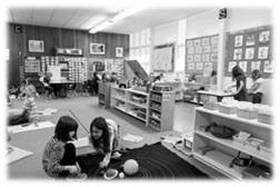Ask people to share their mental image of a Montessori school, and invariably, it goes something like this: Children are gathered in a small groups around the room, often sprawled on the floor, engaged in some sort of a project. They have materials in their hands and strewn around them. Usually the teacher isn't mentioned. Students are focused, interacting, engaging, creating. It's a sharp contrast to the traditional model of students sitting at desks listening to a teacher at the front of the room.
This Montessori model looks and sounds remarkably like the most innovative workplaces of today: small groups of people, gathered together in ever more home-like spaces with sofas, kitchens, lounges and sticky notes scattered on walls and whiteboards. The most successful modern workplaces are abandoning the command-and-control leadership style in favor of new ways of working, and they are grounded in Montessori methods.
This Montessori model looks and sounds remarkably like the most innovative workplaces of today: small groups of people, gathered together in ever more home-like spaces with sofas, kitchens, lounges and sticky notes scattered on walls and whiteboards. The most successful modern workplaces are abandoning the command-and-control leadership style in favor of new ways of working, and they are grounded in Montessori methods.

 RSS Feed
RSS Feed
